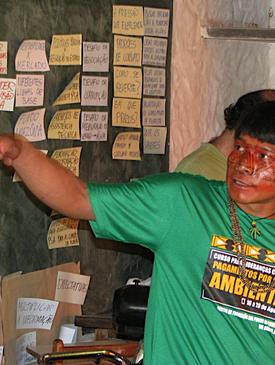Linking Local Communities to Environmental Markets
Summary
In Latin America, Payments for Ecosystem Services (PES) initiatives have become a common and effective approach to conservation, one that compensates landowners for their sustainable land use choices. Aware of the importance of preserving the forests that sustain their tratidional way of life, many local communities are interested in learning more about PES and the alternatives it may offer. This four day course was designed to introduce community leaders from the MAP region MAP (Madre de Dios-Acre-Pando) to PES and its alternatives, through a series of presentations, discussion sessions, field-based exercisea, and a short project development clinic. The course was offered in Portuguese and Spanish.
Content
DAY 1
MODULE 1. Climate Change and Forests – An Introduction to Climate Negotiations and the Importance of PES
- General introduction to climate change, including global trends in climate change, the consequences of climate change worldwide and for the Amazon region more specifically, and the importance of global stewardship. Review of the technical concepts and processes of climate change, such as ecological processes, ecosystems services, and carbon cycles. Brief introduction about the Kyoto Protocol and international climate change negotiations.
MODULE 2. An Introduction to Ecosystem Services
- Introduction to the concept of ‘ecosystem services’ and ‘payments for ecosystem services’ (PES), including: how ecosystems provide services, which services they provide (i.e., hydrological resources, carbon sequestration, and biodiversity), the consequences if these services disappear, and examples of PES initiatives in Latin America. Discussion on how insecure land tenure systems might impact landholders in their ability to protect forest resources and, in turn, ecosystem services and provided examples of this trend in the context of Brazil.
MODULE 3. Ecosystem Services in the State of Acre
- The concept of ecosystem services within the context of Acre: which services are provided by the region’s forests, where they are located, and the primary stakeholders involved in this process. Causes and consequences of deforestation in Acre.
DAY 2
MODULE 4. Field Exercise – Measuring Carbon Stocks
- Basic steps involved in measurement of carbon stocks in small-scale farms, followed by a brief field exercise on carbon measurement.
MODULE 5. Payment and Compensation for Ecosystem Services
- Fundamental concepts regarding the technical and methodological aspects of designing PES mechanisms. Different environmental policy instruments regarding PES, the use of PES mechanism as incentives for conservation. The concept of carbon sequestration and storage, introduction to REDD (Reduced Emissions from Deforestation and Degradation) and concepts related to the development of a REDD initiative (i.e., additionality, baselines, leakage, and permanence).
MODULE 6. Carbon Markets and Opportunities for Local Communities
- Part 1: Differences and similarities between PES and REDD, history of PES initiatives worldwide and in the Amazon more specifically. Introduction to more technical aspects of PES mechanisms: how PES programs work (i.e., the link between clients, markets and payments), basic steps needed to develop a PES project, how to quantify the value of an ecosystem, how to be economically compensated for protecting forest ecosystem services (logic and examples), and different PES strategies that exist to protect natural resources and ecosystem services.
- Part 2: Carbon markets and connections between the climate convention and carbon markets, differences between the regulatory and voluntary markets, and the importance of carbon market for tropical forest conservation. Reforestation vs. REDD. Primary characteristics of ongoing REDD projects and activities. Certification and verification, including what buyers of carbon are looking for in a project.
DAY 3
MODULE 7. The REDD Plan for the State of Acre, Brazil
- The REDD plan for the State of Acre: goals, guidelines and principles of the State’s REDD proposal, who is eligible to participate in the program and how, potential mechanisms included in the proposal to encourage environmental services, priority areas for REDD in the region, reduction goals for carbon emissions, estimated costs for the program, and methods to implement and monitor the program.
MODULE 8. Integrating with the MAP Region
- The MAP region (Madre de Dios, Peru, Acre, Brazil, and Pando, Bolivia) and its importance for conservation and ecosystem services. PES and REDD contibutions to conserve the natural resources of the MAP region, and importance of synergies and alliances between local organizations for the success of conservation efforts.
MODULE 9. How to Develop and Implement PES or Carbon Projects
- Detailed description of basic components of a PES project, and group work to develop hypothetical PES project. Simulation of steps involved for project certification and validation.
DAY 4
MODULE 10. Case studies on PES
- Presentation of 3 PES case studies to illustrate concepts addressed during the previous presentations, as well as the experiences and lessons learned from existing PES initiatives: (1) the JUMA RED project (Brazilian Amazon, State of Amazonas); (2) Bosques Pico Bonito – a carbon forestry project (La Ceiba, Honduras); and (3) the Suruí Carbon Project (Brazilian Amazon, state of Rondônia).
MODULE 11. Developing individual proposals of projects (pre-incubator)
- Introduction to the incubator program run by Forest Trends and the Katoomba Group, which helps communities develop PES initiatives. Development of preliminary project proposal by participants, for a potential PES initiative that should reflect the realities of their communities. presentations to the group.


